Contents
Today, more than 1000 varieties and hybrids of lettuces are grown in the world, but only 10-15 of them can be found on supermarket shelves. What can we say about growing this useful greenery in the garden – a maximum of 2-3 of the most famous species grows in any garden. Meanwhile, all varieties of lettuce are very different. They differ in the shape, color and size of the leaves. But one thing unites them – a high content of vitamins and low calorie content (13-15 kcal), making salads a unique product for those who care about their health.
Lettuce
The most famous and widely used variety, with about 100 varieties. Lettuce is head and leaf. The first forms free rosettes of curly leaves, the second leaves are more even and collected in dense heads at the base. The salad does not have a pronounced taste, rather its taste is insipid or neutral, so it is an ideal addition to products with a more pronounced taste.
Lettuce leaves are quite tender, so it is recommended not to cut them, but to tear them with your hands. It is used fresh – it is put in sandwiches, cold dishes are decorated with curly leaves. So that the greens do not lose their juiciness, they are briefly placed in water. In the cold, lettuce can be stored for 2-4 days.

Lollo Rossa
A very beautiful and popular hybrid of lettuce, but unlike it, it has a slight nutty flavor with a slight bitterness. The leaves are green at the base and red-brown at the edges. Represented by several hybrid varieties. Its most famous species: Lollo Bionda, Nika, Barbados.
The leaves are large and soft. You can use the salad fresh, as well as in combination with sauces, any hot meat and vegetable dishes, shish kebab. Lollo Rossa is highly decorative, so it is often used for serving dishes. In the cold, it is stored no more than 2 days.
Korn
This salad is a small oval leaves of rich dark green color, collected in small rosettes. It has a delicate spicy aroma that is not immediately caught. The taste is intense, sweetish-nutty. In order not to suppress this taste, only olive oil is recommended as a dressing for greens.
Corn goes well with many products: bacon, croutons, nuts, onions. In a fresh salad, chicory salad can pair with him. Although it is a salad green, the corn pairs well with citrus fruits, and in some countries it is served with berry sauces. In the cold, Korn retains its freshness for up to 3 days.
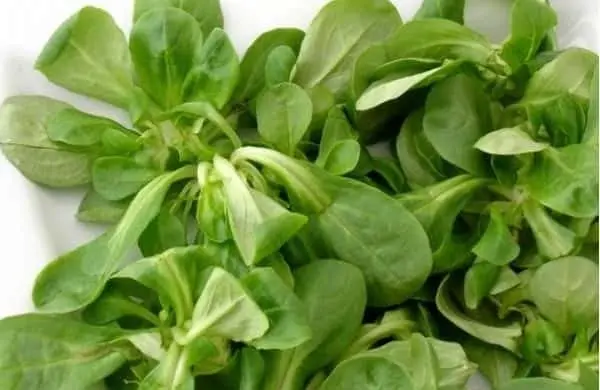
Romano
It is also called romaine, or Roman lettuce. It has a slightly tart sweetish-nutty taste and a delicate spicy aroma that is not lost in combination with other herbs. Based on it, many hybrids have been bred. Remus, Monavert, Dandy, Xanadu, Wendel are some of the hybrid species of the Romano variety.
The leaves are juicy, crisp, long (up to 30 cm), dense, intense dark green color with white fleshy seal at the base. Depending on the type, they are collected in dense sockets or heads of cabbage, reaching a weight of 300 g. Romano can be consumed fresh without any additives, it can also be a savory addition to vegetable salads, sandwiches, and various dressings. In addition, Romano is used in the classic version of the Caesar salad.
Watercress
A very savory plant containing mustard oil in its juicy green leaves, thanks to which the greens have a characteristic taste similar to horseradish in sharpness. Watercress is famous for its useful, one might say healing properties and a high concentration of vitamins, so it is often grown in vegetable gardens in the garden. Watercress greens are similar in appearance to spinach or Korn lettuce – the leaves are the same oblong and smooth.
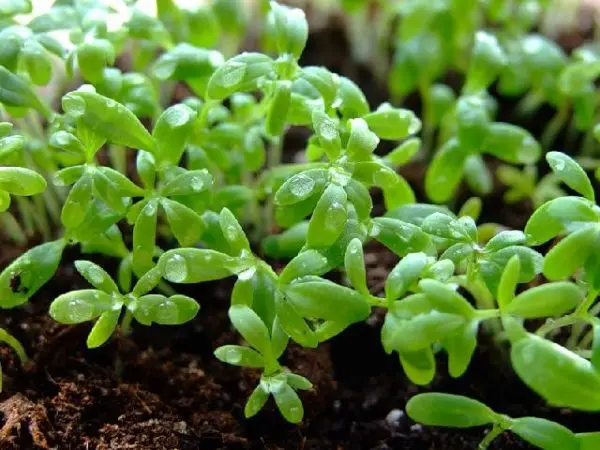
In cooking, watercress has the widest application: it goes well with vegetables, it can add a special piquancy to any dish. It is also an excellent seasoning for meat, especially cutlets, chops. Leaves can be used to make green oil for canapés and sandwiches. It is used both fresh and stewed, although during processing it loses some of its useful substances, but the taste also becomes softer.
Video “The benefits of different types of leaf lettuce”
This video provides a description of the different types of lettuce, and you can also hear tips on choosing greens.
Ruccola
A very popular salad green with unusual intense green leaves that look like dandelion leaves. It has a peculiar aroma and spicy taste, reminiscent of a mixture of nuts, mustard and pepper. Unlike other types of salad greens, it does not grow in rosettes or heads of cabbage, but in separate stems, to which spicy leaves are attached.
As a dressing for arugula, vinegar, vegetable, olive oil is better. It goes well with fresh tomatoes, cheese, it can be added to vegetable salads, as well as steamed, serve as a side dish for meat, fish. Arugula leaves quickly wither, so greens cannot be stored for a long time.

Spinach
The most popular salad greens, widely known for their high vitamin content and low calorie content. Spinach grows in small rosettes, the leaves, depending on the variety, can be smooth or wrinkled, and differ in color intensity. In our latitudes, the culture can be grown year-round: in winter in pots, in summer – in the garden. Spinach leaves have a pleasant, slightly sweet taste.
It is good both fresh and blanched, and during processing, these greens retain vitamins and proteins. It is better to use young spinach leaves for food – they have a more subtle and delicate taste. In the cold, spinach stays fresh for about a week.
Iceberg
The most famous and bought lettuce with dense leaves of a light green color, collected in a fairly large head (from 300 g to 1 kg). An iceberg can be stored in the refrigerator for 3-4 weeks, and at the same time its leaves do not lose their juiciness and crunchiness. It has a neutral, slightly sweet aftertaste, so it goes well with any sauce, dressing. Iceberg can be used as part of vegetable salads, as a side dish for fish, meat, seafood, or as an addition to sandwiches. Also, cabbage rolls can be prepared from its leaves. When choosing a quality salad, you should pay attention to the density of the heads – they should not be too soft (empty), or too dense.
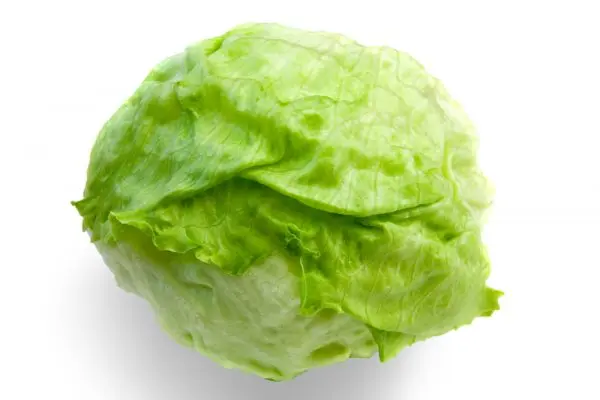
Radiccio
A very popular head lettuce in Italy, a hybrid of the chicory known to us. The shape of the loose heads resembles cabbage, but the leaves have an intense purple color. Green types of Radicchio are distinguished by a dark green leaf color with dense burgundy veins. The taste of lettuce is bitter, intensely expressed. The use of Radicchio in cooking is quite diverse: it can be eaten raw, mixed with other fats, used as a side dish for cape, hot vegetables, and also added to vegetable sauteed. Mayonnaise, honey sauce, citrus juices are suitable for dressing juicy leaves.
Friese
The name of the salad is translated from French as “curly”. Its leaves are narrow and really very curly with an intense green color, which gradually changes to yellow towards the center of the rosette. It is this yellow center that has a delicate taste and is completely devoid of bitterness. Lettuce used to be tied up by depriving it of daylight to get those delicate light leaves, but hybrids have now been introduced that lighten up on their own and don’t need to be tied up.
Frize leaves have a slight bitterness, due to their high decorativeness they are used to decorate dishes. Lettuce goes well with other salad greens, perfectly sets off the taste of meat, shrimp, fish, soft cheeses. Spicy greens are the perfect complement to fried bacon, meat sandwich. Vinegar and vegetable oil are suitable for dressing Frise.
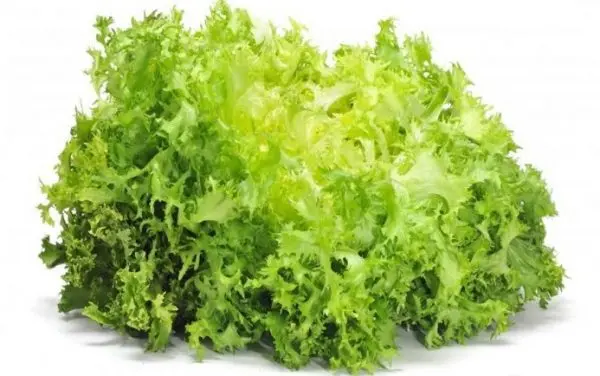
Lollo Bionda
Leaf lettuce with beautiful curly leaves of bright green color. It is a hybrid of lettuce and a variety of the well-known Lollo Ross. The taste is nutty, light, with bitterness. In high concentration contains vitamins B, A, C, calcium, iron. It is recommended to fill the greens with balsamic vinegar, citrus juice, olive oil.
Lollo Bionda goes well with many foods, including fried meat, barbecue, hot vegetables. Corrugated greens are good as the main element of fresh vegetable salads. The leaves of the plant are quite tender and crispy, so lettuce is often sold in pots to extend the shelf life of the product.
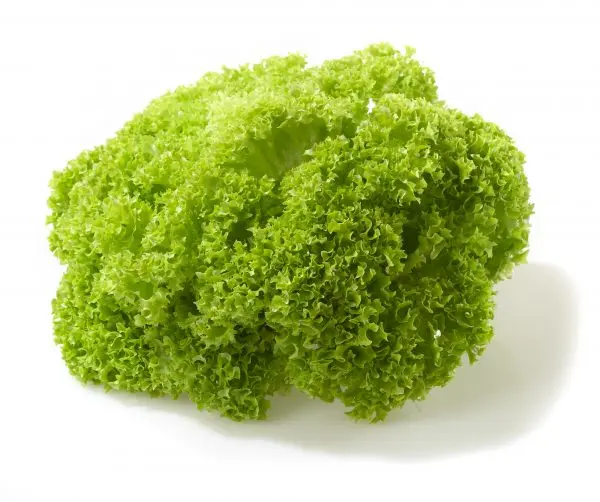
Oak
This salad got its name due to the original leaves of green-brown color, outwardly similar to oak. Its most famous species are: Amorix, Asterix, Dubachek, Dubrava, Zabava. It has a bright taste with a slight nutty tint, so it is better to combine it with dishes without a dominant aroma. Lettuce leaves do not tolerate temperature changes – in the refrigerator, greens are stored for no more than a day.
Oak salad is good in combination with champignons, avocado, salmon, any hot appetizers. It can be served with fried croutons and fish. Light sauces, any vegetable oil, vinegar are recommended for dressing the leaves.

Video “Types, processing and storage of salads”
Video recommendations for choosing different varieties of leaf lettuce with practical tips for storing them.









